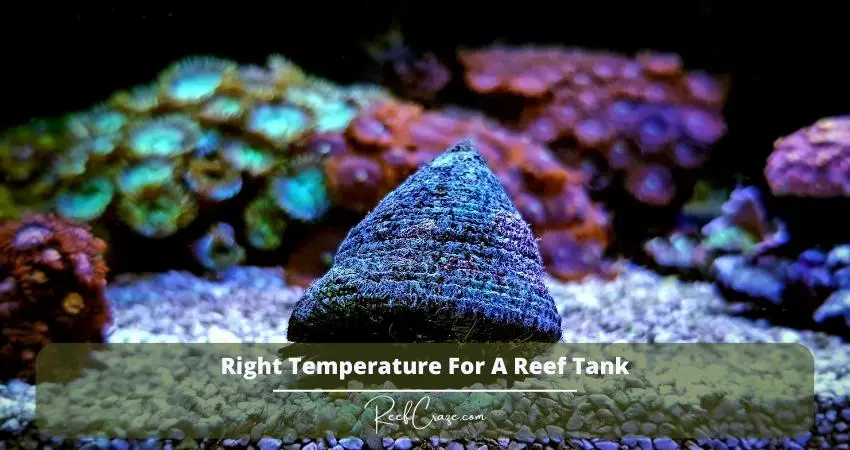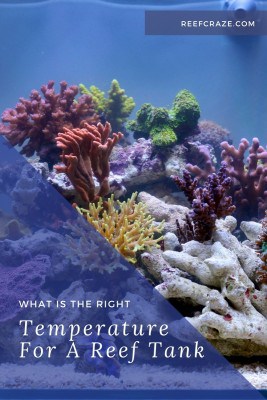Even if you are a beginner, it should not come as a shock to you that maintaining a reef tank is not a piece of cake. There are a number of things to take care of and an important one of them is maintaining the right temperature in a reef tank. This is because the inhabitants of a tank are highly susceptible to temperature changes.
The ideal temperature of a reef tank varies from one type of water to another. If you have a warm water reef tank, the right temperature will range from 75 to 85 degrees Fahrenheit. But if it is a cold water tank, the right temperature will be somewhere between 50 and 65 degrees Fahrenheit.
The rest of the article will shed light on the topic from a much broader perspective. If you are a hobbyist, please keep reading. I’m sure it will come in handy when you have to make decisions regarding your tank and its inhabitants!

Why Is Temperature An Important Parameter For A Reef Tank?
Very simple. It is difficult for corals and other creatures to process oxygen and function properly when the temperature of a reef tank is not ideal. Sudden changes in temperature can easily make your tank inhabitants stressed and sick, or even worse – cause death!
That is why it is essential to understand the importance of temperature and keep it stable all the time.
How Do I Determine The Appropriate Temperature?
I already told you how much your tank temperature range should be according to its water type. But there is a better way to determine the accurate temperature.
Just find out where your chosen corals and other creatures grew when they were in the wild and then you’ll easily get information about the temperature. Or, you can ask the local fish store where the corals were shipped from and get an idea about it.
How Do I Keep The Temperature Stable?
The most effective ways to keep the temperature stable in a reef tank are aquarium heaters and aquarium chillers. During hot weather, it is not necessary to use a heater to keep the water warm but you can still use it to regulate the temperature fluctuations. On the other hand, a water chiller is usually needed for cold water reef tanks and for tanks that are kept in extremely hot climates.
To stabilize the temperature, set your chiller or heater so that it can automatically keep the tank water within the ideal range of temperature. You should also double-check it by using an in-tank thermometer.
Additional Read: How to keep reef tanks cool without a chiller
Does The Type Of A Tank Impact The Temperature Fluctuations?

Yes, it does. The bigger your reef tank is, the less its temperature will fluctuate. It is because it takes
more time to heat or cool when there are larger water volumes in a tank.
For instance, suppose you have shut off the lighting at night. In a nano cube aquarium that holds only 10-20 gallons of water, the temperature will fluctuate quicker.
But if your reef tank is quite big and has 150-200 gallons of water, keeping the lights off for 12-14 hours will not be long enough to cause a significant change in the water temperature.
However, keep in your mind that the temperature can vary with different areas of your reef tank. It depends on the type of heating system that you use and where you place it in the tank.
Although the choice is yours, let me tell you that you may get better results if you use an in-line heater. It regulates the temperature more efficiently than a submersible heater.
Why Is Overheating A Problem For My Reef Tank?
There are some serious problems associated with overheating. Higher temperatures result in a lower level of dissolved oxygen (DO) in water which can be harmful to each of your tank inhabitants.
Higher temperatures also make materials decompose faster. It also increases the reproduction rate of bacteria which consumes more oxygen and lowers the level of DO in the tank water.
Drastic temperature changes can also cause harm to the zooxanthellae algae which provide your corals with nutrition. Overheating can force them to abandon the corals which will lead to coral bleaching and their demise eventually.
How To Keep The Tank From Overheating?
Although you can use an aquarium chiller or heater to keep the temperature of your tank stable, there are some other methods to follow if your tank overheats and you need to control it. All of them work to different extents.
- If you have an air conditioner, use it right away. It will efficiently keep the ambient temperature stable and cool. In case there is no central air conditioning, you might have to invest in a window unit in the room where you keep your tank.
- If it is possible, try to keep the lights off for some time during the day. This is necessary if you have metal halide lights because they get extremely hot when they are switched on. This method is not a solution for temperature fluctuations. But it will help in keeping the water from getting too hot. However, before you make a decision about this, make sure that reducing the lighting time will not have detrimental effects on any of the tank inhabitants.
- Prevent the sunlight from directly shining on your tank from the window. Also, consider closing the blinds during the afternoon so that the sun cannot heat up the room. It will make the room cooler by a few degrees. It is also beneficial to avoid direct sunlight for minimizing the chance of algae overgrowth in the tank.
- If the pumps are housed in a closed-off stand under your reef tank, it can also increase the water temperature through the tank’s bottom. You can solve this problem by keeping the stand door open and placing a fan so that it can circulate the air underneath the tank.
- You can also use fans to keep your tank from overheating. They are good at decreasing the temperature when placed inside the hood of the tank. You can either buy them from markets or get some from an old computer and place them in your tank.
- Another way is that you can remove a part of the hood and keep the fan facing the water surface. Remember to cover the tank using a net to prevent the acrobatic fish from jumping out. Moreover, be aware that using fans will make the tank water evaporate faster.
Final Words
If you take the time to set up your tank properly and perform all the maintenance tasks, there should not be anything wrong with your reef tank. And do remember that temperature is an important parameter that impacts almost everything in the tank.
So, to ensure that everything inside your tank is safe and sound, determine the right temperature and follow the discussed steps in the article to keep it stable. Monitor the tank regularly for temperature fluctuations and if there is any noticeable change, you already know what you will have to do, right?
Best wishes!
